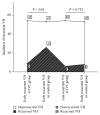A Randomized Controlled Trial of Conbercept Pretreatment before Vitrectomy in Proliferative Diabetic Retinopathy
- PMID: 27034822
- PMCID: PMC4808544
- DOI: 10.1155/2016/2473234
A Randomized Controlled Trial of Conbercept Pretreatment before Vitrectomy in Proliferative Diabetic Retinopathy
Abstract
Purpose. To determine the efficacy and safety of preoperative intravitreal conbercept (IVC) injection before vitrectomy for proliferative diabetic retinopathy (PDR). Methods. 107 eyes of 88 patients that underwent pars plana vitrectomy (PPV) for active PDR were enrolled. All patients were assigned randomly to either preoperative IVC group or control group. Follow-up examinations were performed for three months after surgery. The primary bioactivity measures were severity of intraoperative bleeding, incidence of early and late recurrent VH, vitreous clear-up time, and best-corrected visual acuity (BCVA) levels. The secondary safety measures included intraocular pressure, endophthalmitis, rubeosis, tractional retinal detachment, and systemic adverse events. Results. The incidence and severity of intraoperative bleeding were significantly lower in IVC group than in the control group. The average vitreous clear-up time of early recurrent VH was significantly shorter in IVC group compared with that in control group. There was no significant difference in vitreous clear-up time of late recurrent VH between the two groups. Patients that received pretreatment of conbercept had much better BCVA at 3 days, 1 week, and 1 month after surgery than control group. Moreover, both patients with improved BCVA were greater in IVC group than in control group at each follow-up. Conclusions. Conbercept pretreatment could be an effective adjunct to vitrectomy in accelerating postoperative vitreous clear-up and acquiring stable visual acuity restoration for PDR.
Figures




References
-
- Hershberger V. S., Augsburger J. J., Hutchins R. K., Raymond L. A., Krug S. Fibrovascular ingrowth at sclerotomy sites in vitrectomized diabetic eyes with recurrent vitreous hemorrhage: ultrasound biomicroscopy findings. Ophthalmology. 2004;111(6):1215–1221. doi: 10.1016/j.ophtha.2003.08.043. - DOI - PubMed
LinkOut - more resources
Full Text Sources
Other Literature Sources
Medical
Miscellaneous

